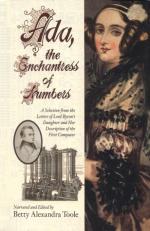|
This section contains 341 words (approx. 2 pages at 300 words per page) |
English Mathematician and Scientist
1815–1852
 Ada Byron Lovelace is credited with writing the world's first computer program when she wrote instructions for Charles Babbage's Analytical Engine.
Ada Byron Lovelace is credited with writing the world's first computer program when she wrote instructions for Charles Babbage's Analytical Engine.
Ada Lovelace was born Augusta Ada Byron, the daughter of the poet George Gordon (Lord Byron) and the mathematician and heiress Anne Isabella Milbanke. Although Lovelace inherited poetic inclinations from her father, her mother raised her to be a mathematician, and she subsequently contributed significantly to the earliest work on mechanical computing machines.
Lovelace received her early education at home and was assisted in her advanced studies by mathematician Augustus De Morgan and scientist Mary Somerville. Presented at court in 1833, she married William, eighth Lord of King, in 1835. He subsequently became Earl of Lovelace, and she became Countess of Lovelace.
Although involved in London society, Lovelace was interested in mathematics, particularly the calculating machines proposed by Charles Babbage, professor of mathematics at Cambridge. After Lovelace met Babbage, the pair became friends and coworkers.
Babbage proposed mechanical devices—the Difference Engine in 1833 and the more complex Analytical Engine in 1838—that would be able to make numerical calculations. Lovelace translated an Italian article describing Babbage's Analytical Engine and added commentary that was three times the length of the original article. Published in 1843, this article clearly shows that she was the first person to understand fully the significance of Babbage's inventions.
In the article, Lovelace described how the calculating machine could be programmed to compute Bernoulli numbers, foreshadowing modern computer programming. She also predicted the use of mechanical mathematical devices for such purposes as music composition and the production of graphics. Although thought to be whimsical at the time, her predictions have turned out to be quite accurate.
See Also
Babbage, Charles; Computers, Evolution of Electronic; Mathematical Devices, Mechanical.
Bibliography
Toole, Betty A., ed. Ada, the Enchantress of Numbers: A Selection from the Letters of Lord Byron's Daughter and Her Description of the First Computer. Mill Valley, CA: Strawberry Press, 1992.
Woolley, Benjamin. The Bride of Science: Romance, Reason, and Byron's Daughter. New York: McGraw Hill, 1999.
|
This section contains 341 words (approx. 2 pages at 300 words per page) |


